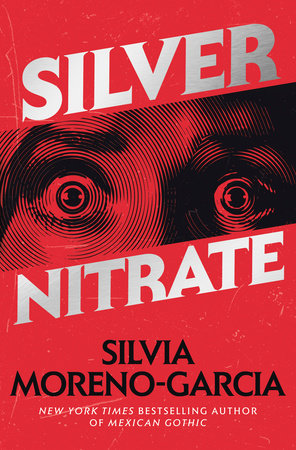I really enjoyed reading Silvia Moreno-Garcia’s Silver Nitrate (2023). I admit I bounced off The Daughter of Doctor Moreau last year, but I found Gods of Jade and Shadow (2019) quite interesting, and I loved the anthology she edited, She Walks in Shadows (2015). So I was ready to give another book of hers a try when I saw her name on a cover at my library, and when I saw the inside jacket description, it was a sudden must-read.
“Montserrat has always been overlooked. She’s a talented sound editor, but she’s left out of the boys’ club running the film industry in ‘90s Mexico City. And she’s all but invisible to her best friend, Tristán, a charming if faded soap opera star, though she’s been in love with him since childhood. Then Tristan discovers that his new neighbor is the cult horror director Abel Urueta, and the legendary auteur claims that he can change their lives – even if his tale of a Nazi occultist imbuing magic into highly volatile silver nitrate stock sounds like fantasy…”

I’ve done some audio editing for the Skiffy and Fanty Show podcast; I find the process interesting and rewarding, and I’m interested to hear about other sound editors’ work (although, since this is set in the 1990s, Montserrat isn’t using audio software like today’s). Also, I’ve long been a fan of old movies and the history of cinema (I highly recommend Karina Longworth’s “You Must Remember This” podcast series). I know a little bit about Mexico, mostly from Mike Duncan’s “Revolutions” podcast series (Season 5, “Spanish American wars of independence” and Season 9, “Mexican Revolution”), although sadly, even though I went to college in San Antonio, Texas, I never took the opportunity to visit Mexico. And I know a little Spanish from Duolingo, but it’s sparsely scattered through the book, mostly as flavor text, and I don’t think a non-Spanish reader will miss anything at all that can’t be understood from context. Anyway, the description of this novel hit a lot of buttons for me, so I was eager to read it. And as a horror novel, it’s perfect for an October review.
Not that I was sure it was going to be anything more than psychological horror for quite some time. Before anything remotely spooky happens, the book takes its time letting us get to know Montserrat and Tristán first. Montserrat takes no nonsense from anyone, which doesn’t win her many friends and allies; if she and Tristán hadn’t become friends in childhood after she saved him from some bullies by using her cane as a club, she might never talk to anyone outside work except for her sister, Araceli. Tristán, on the other hand, knows a lot of people and has had a lot of relationships, with both men and women, but none of them last; his career has suffered since his lover, Karina, crashed and died 10 years ago with him in the car; his face was scarred and he was addicted to painkillers for a while. He’s not as prickly as Montserrat, but he can be pretty self-centered.
Things start looking up for both of them when he changes apartments and meets a retired director; Tristán stops dwelling so much on his tragic past, and Karina hopes she may be able to move into documentary work by pitching a project on Uduerto’s old, unfinished film, Beyond the Yellow Door. Uduerto’s price for agreeing to be interviewed is for them to help him actually finish the film by dubbing their voices into the final scene. He believes this will break a curse on the film (and on him, and others involved in the movie) that arose due to the scriptwriter, Wilhelm Ewers, a Nazi occultist who had fled to Mexico and built a following there, adapting his ideas about Aryan superiority to include Aztec and Maya elements. Ewers believed that silver nitrate filmstock could hold a magical charge, and showing it to an audience would fulfill a ritual to cast a spell; however, when Ewers died in a mugging, one of his followers withdrew her funding for the film, and the project fell apart.
For a while after the dubbing is finished, all their lives improve in various ways; however, Tristán starts getting vivid dreams of crash-killed Karina, Montserrat feels like she’s being followed, and when they reach out to other people who’d been involved in Beyond the Yellow Door, things keep escalating. Montserrat’s research pulls them in dangerous directions, but she’s clever and creative, and Tristán ends up acting beyond his own concerns for once, and the book ends in an exciting and satisfying way. Especially the bit at the very end, which I won’t spoil, but I loved it!
Film and other media having special powers is not original to this book, of course. People have claimed for more than a century to see ghost-shadows caught in photographs. Robert E. Howard wrote “Casonetto’s Last Song,” about a phonograph record that conveyed a death curse from a devil-worshipper, around 1930, although the short story wasn’t published until 1973. The most pertinent example of this topic that I can think of is the book Flicker (1991), by Theodore Roszak, about a film professor who gets into trouble through his research into a German film director connected with a religious cult.
However, Moreno has her own take on this concept, and does a great job executing it, with the slow build, the worldbuilding and atmosphere, the revelations, and most of all for me, the imperfect yet compelling characters. I loved it!
Content Warnings: ableism against protagonists; references to drug use; some violence, a little gore, deaths; racism (not by protagonists); Nazi occultism; ghosts, magic, black magic.
Comparisons: Robert E. Howard’s short story “Casonetto’s Last Song” (1973); Theodore Roszak’s novel Flicker (1991).
Disclaimers: None.








One Response
Put higher on the ‘to read’ list… The novel sounded from blurbs like a riff on Elizabeth Hand’s Generation Loss and a Clive Barker novel (which would work, even if this is not that.) Thanks for the podcast recommendation, too – never too many movie history podcasts.